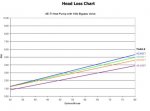Hello,
A catastrophic freeze event this winter cracked both my salt cell and heat pump caused by a Intermatic freeze switch failure. After the failure, I cut out both the heater and cell so the pool could continue to filter and I was in no rush to replace the components until the spring.
I've since replaced the Jandy AE-TI heat pump with a Jandy JXi 400k gas heater and the salt cell with another AquaPure, but now have the 3 port version. While adding the new components, I was able to remove 7 90degree bends in the pipe after the filter (yes, you read that correctly 7). After replacing all the components, I'm seeing much higher head loss and GPM though the pump.
Just so happens that I bought a check value flow gauge and put that in prior to adding the new gas heater. The reading before the new heater was about 95 GPM, but this was with the heat pump and old cell removed; however, the pressure at the return seemed about the same (based on feel) as with the two components.
Now with the new heater, the GPM has dropped to about 80 and the pressure at the filter has increased about 5psi. I first noticed the change since the pump was running quieter and the pump did not care if I closed off any of the inflow pipes. Before it would complain if it did not have at least two inflows wide open. The pressure at the returns is noticeably less.
I's not considering the new salt cell as an issue, since it has a larger cavity than the previous and allow more water to pass.
I contacted Zodiac/Jandy asking them for the head loss chart for my old Heat Pump and compared that to the new JXi chart. Yes there is more loss, but I'd think the more efficient plumbing after the heater would make up for that. The heat pump did have a built in by-pass (that's the **** part that cracked) and I think that is how it moved water so well. I'm thinking the efficiency no the new heater wants as much cool water through it as possible, so it has no bypass.
I plan to live with it, but I'd like to make some sense of it.
Thanks
Gary


A catastrophic freeze event this winter cracked both my salt cell and heat pump caused by a Intermatic freeze switch failure. After the failure, I cut out both the heater and cell so the pool could continue to filter and I was in no rush to replace the components until the spring.
I've since replaced the Jandy AE-TI heat pump with a Jandy JXi 400k gas heater and the salt cell with another AquaPure, but now have the 3 port version. While adding the new components, I was able to remove 7 90degree bends in the pipe after the filter (yes, you read that correctly 7). After replacing all the components, I'm seeing much higher head loss and GPM though the pump.
Just so happens that I bought a check value flow gauge and put that in prior to adding the new gas heater. The reading before the new heater was about 95 GPM, but this was with the heat pump and old cell removed; however, the pressure at the return seemed about the same (based on feel) as with the two components.
Now with the new heater, the GPM has dropped to about 80 and the pressure at the filter has increased about 5psi. I first noticed the change since the pump was running quieter and the pump did not care if I closed off any of the inflow pipes. Before it would complain if it did not have at least two inflows wide open. The pressure at the returns is noticeably less.
I's not considering the new salt cell as an issue, since it has a larger cavity than the previous and allow more water to pass.
I contacted Zodiac/Jandy asking them for the head loss chart for my old Heat Pump and compared that to the new JXi chart. Yes there is more loss, but I'd think the more efficient plumbing after the heater would make up for that. The heat pump did have a built in by-pass (that's the **** part that cracked) and I think that is how it moved water so well. I'm thinking the efficiency no the new heater wants as much cool water through it as possible, so it has no bypass.
I plan to live with it, but I'd like to make some sense of it.
Thanks
Gary



